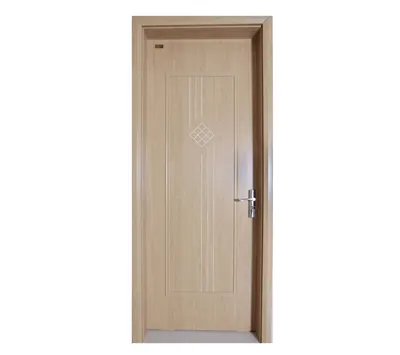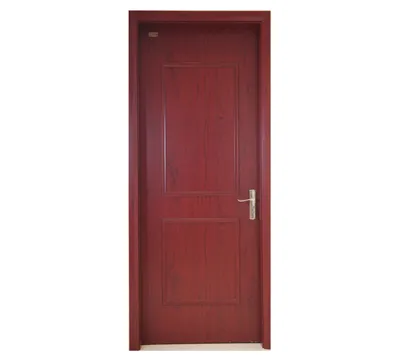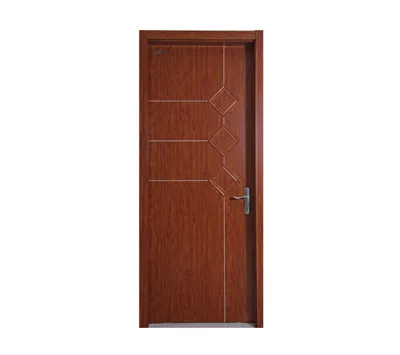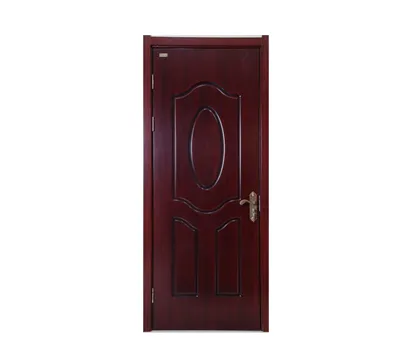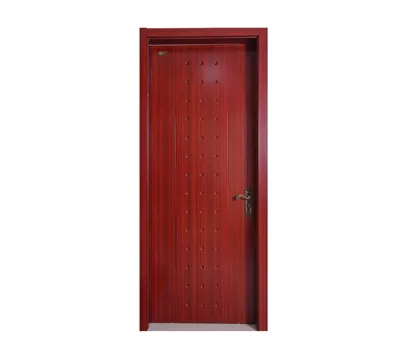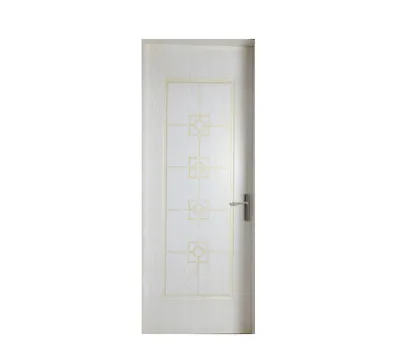
Ecological interior door selection method: Four views Look at the finish (shape and paint color); Second, the certificate (toxic substance content); Third, look at the material (solid wood); Look at the workmanship (whether the size is regular and the seams are tight).
Only by mastering these "four looks" can you not distinguish the true from the false in the maze of doors.
Hear When selecting solid wood doors, consider their thickness. Gently tap the surface with your hand – if the sound is even and muffled, this indicates good quality.
Weight: Generally, doors with higher solid wood content tend to be heavier.
Pure solid wood doors typically feature very irregular surface patterns.
If the surface appears smooth, neat, and attractive at first glance, it usually isn't a genuine solid wood door.
paint As a post-processing step in the manufacturing of wooden door kits, its quality directly impacts the final performance.
Additionally, paint costs constitute one of the most significant expenses in wooden door production.
Paint types are mainly categorized into phenolic resin paint, alkyd paint, polyurethane paint, nitrocellulose paint, polyester paint, and PU paint.
Among these, phenolic resin and alkyd paints have been largely phased out in interior decoration due to their poor film texture and adhesion strength. The mainstream choices now are nitrocellulose paint, polyester paint, and PU paint used in high-end furniture manufacturing.
Nitrocellulose paint, favored for its simple application process and suitability for manual work, remains widely used in handmade decorative woodwork. However, its thin film thickness results in a subpar surface texture and less than ideal visual effects.
Due to issues with cost processing methods and equipment, 90% of wooden door sets on the market use polyester paint, while a few manufacturers adopt PU paint.
Generally, both polyester and PU paints go through six processes: color matching, three primers, two coats, and surface treatment. Some brands add curing and waxing processes.
Therefore, in the choice of wood door, paint is one of the factors to consider, it directly affects the texture, hand feel, moisture resistance, environmental protection, durability, resistance to yellowing and other issues.
Choosing techniques 1. Start with style and color.
The purpose of home renovation is to create a warm and harmonious living environment. Therefore, when selecting wooden doors, the primary consideration should be their style and color coordination with the room's interior design.
For a serene and understated decor, choose elegant and simple designs; for a lively and vibrant look, opt for light and refined styles; for classical and comfortable aesthetics, emphasize substantial and refined elements.
In summary, it's recommended to choose styles that are similar in category, 2. Color Coordination Strategy.
Effective color coordination is the cornerstone of interior design. After finalizing the overall style, the next crucial step is matching the wooden door's color with the room's existing hues.
The ideal approach involves using analogous colors as the base, complemented by contrasting elements. Start by categorizing the space's color scheme and lighting conditions into three primary color systems: walls, floors, and furniture soft furnishings.
Stick to these three systems without overcomplicating the mix.
For doors, choose colors near your furniture palette – like pairing dark flooring with white walls and purplewood doors.
Maintain balance between contrast and harmony within the space.
For beginners without professional guidance, adopt this "alignment" strategy: Instead of forcing contrasts, let the room's natural variations speak for themselves. Align door color with dominant surfaces (floors, walls, or furniture), then accentuate details like matching wood grain patterns.
The specific color pair should be determined through careful consideration of practical needs.
After thorough consideration of design and color schemes, the next critical phase involves assessing craftsmanship and quality control.
Since direct factory supervision is impractical, we rely on visual inspection methods to evaluate production quality.
Two essential techniques are recommended: tactile examination and side lighting inspection.
Gently caress the door's edges, panels, and corners for smooth, scratch-free surfaces. Then stand at the door's side facing the light to visually check the painted surface for uneven or wavy patterns.
These two methods effectively determine whether the craftsmanship meets industry standards.
4. Inspection materials and relevant manufacturer qualification certificates.
However, relying solely on the above does not guarantee purchasing satisfactory and reliable wooden doors. What are the materials used inside the wooden door?
Are they environmentally friendly?
Here we can conduct inspections through three aspects: First, prioritize manufacturers with good brand reputation. The Wood Door Professional Committee of China Timber Circulation Association convened an industry conference in Beijing, where the conference selected the top 30 member enterprises of China's wood door industry through rigorous research and evaluation.
These manufacturers demonstrate standardized practices in scale, product quality, and service systems.
Second, verify whether the manufacturer's relevant qualification certifications comply with industry standards to assess the completeness and authenticity of their product structure.
Third, pay attention to inspecting the internal materials at the door lock hole area before installation for final quality control.
Additionally, price is another aspect of quality measurement. Genuine products cannot be too cheap; each category has its own cost. A quote that is low compared to the cost limit should be questioned. For example, the production cost of a solid wood door should be around 3,000 yuan. If a merchant quotes 2,500 yuan, there is definitely an issue.
In short, the selection of interior doors should follow the above steps, so as to avoid the mistake of being led by the nose by the business.
More ecological interior door related content, welcome to call for consultation.

Ecological interior door selection method: Four views Look at the finish (shape and paint color); Second, the certificate (toxic substance content); Third, look at the material (solid wood); Look at the workmanship (whether the size is regular and the seams are tight).
Only by mastering these "four looks" can you not distinguish the true from the false in the maze of doors.
Hear When selecting solid wood doors, consider their thickness. Gently tap the surface with your hand – if the sound is even and muffled, this indicates good quality.
Weight: Generally, doors with higher solid wood content tend to be heavier.
Pure solid wood doors typically feature very irregular surface patterns.
If the surface appears smooth, neat, and attractive at first glance, it usually isn't a genuine solid wood door.
paint As a post-processing step in the manufacturing of wooden door kits, its quality directly impacts the final performance.
Additionally, paint costs constitute one of the most significant expenses in wooden door production.
Paint types are mainly categorized into phenolic resin paint, alkyd paint, polyurethane paint, nitrocellulose paint, polyester paint, and PU paint.
Among these, phenolic resin and alkyd paints have been largely phased out in interior decoration due to their poor film texture and adhesion strength. The mainstream choices now are nitrocellulose paint, polyester paint, and PU paint used in high-end furniture manufacturing.
Nitrocellulose paint, favored for its simple application process and suitability for manual work, remains widely used in handmade decorative woodwork. However, its thin film thickness results in a subpar surface texture and less than ideal visual effects.
Due to issues with cost processing methods and equipment, 90% of wooden door sets on the market use polyester paint, while a few manufacturers adopt PU paint.
Generally, both polyester and PU paints go through six processes: color matching, three primers, two coats, and surface treatment. Some brands add curing and waxing processes.
Therefore, in the choice of wood door, paint is one of the factors to consider, it directly affects the texture, hand feel, moisture resistance, environmental protection, durability, resistance to yellowing and other issues.
Choosing techniques 1. Start with style and color.
The purpose of home renovation is to create a warm and harmonious living environment. Therefore, when selecting wooden doors, the primary consideration should be their style and color coordination with the room's interior design.
For a serene and understated decor, choose elegant and simple designs; for a lively and vibrant look, opt for light and refined styles; for classical and comfortable aesthetics, emphasize substantial and refined elements.
In summary, it's recommended to choose styles that are similar in category, 2. Color Coordination Strategy.
Effective color coordination is the cornerstone of interior design. After finalizing the overall style, the next crucial step is matching the wooden door's color with the room's existing hues.
The ideal approach involves using analogous colors as the base, complemented by contrasting elements. Start by categorizing the space's color scheme and lighting conditions into three primary color systems: walls, floors, and furniture soft furnishings.
Stick to these three systems without overcomplicating the mix.
For doors, choose colors near your furniture palette – like pairing dark flooring with white walls and purplewood doors.
Maintain balance between contrast and harmony within the space.
For beginners without professional guidance, adopt this "alignment" strategy: Instead of forcing contrasts, let the room's natural variations speak for themselves. Align door color with dominant surfaces (floors, walls, or furniture), then accentuate details like matching wood grain patterns.
The specific color pair should be determined through careful consideration of practical needs.
After thorough consideration of design and color schemes, the next critical phase involves assessing craftsmanship and quality control.
Since direct factory supervision is impractical, we rely on visual inspection methods to evaluate production quality.
Two essential techniques are recommended: tactile examination and side lighting inspection.
Gently caress the door's edges, panels, and corners for smooth, scratch-free surfaces. Then stand at the door's side facing the light to visually check the painted surface for uneven or wavy patterns.
These two methods effectively determine whether the craftsmanship meets industry standards.
4. Inspection materials and relevant manufacturer qualification certificates.
However, relying solely on the above does not guarantee purchasing satisfactory and reliable wooden doors. What are the materials used inside the wooden door?
Are they environmentally friendly?
Here we can conduct inspections through three aspects: First, prioritize manufacturers with good brand reputation. The Wood Door Professional Committee of China Timber Circulation Association convened an industry conference in Beijing, where the conference selected the top 30 member enterprises of China's wood door industry through rigorous research and evaluation.
These manufacturers demonstrate standardized practices in scale, product quality, and service systems.
Second, verify whether the manufacturer's relevant qualification certifications comply with industry standards to assess the completeness and authenticity of their product structure.
Third, pay attention to inspecting the internal materials at the door lock hole area before installation for final quality control.
Additionally, price is another aspect of quality measurement. Genuine products cannot be too cheap; each category has its own cost. A quote that is low compared to the cost limit should be questioned. For example, the production cost of a solid wood door should be around 3,000 yuan. If a merchant quotes 2,500 yuan, there is definitely an issue.
In short, the selection of interior doors should follow the above steps, so as to avoid the mistake of being led by the nose by the business.
More ecological interior door related content, welcome to call for consultation.
